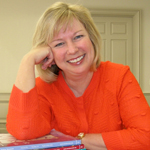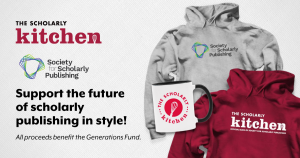Publisher and Head of the Publishing Division for the American Association for Cancer Research
 First, tell us a bit about yourself (hometown, current locale, family, hobbies, community involvement?). What is your current job?
First, tell us a bit about yourself (hometown, current locale, family, hobbies, community involvement?). What is your current job?
I grew up in a row house in Baltimore (a city where everyone calls you “hon”), the youngest of five children. Although I have some recollection of rulers connecting with hands in the Catholic schools I mostly attended, I have generally fond memories of my early education. After high school I attended business college and then worked for a few years in administrative positions at the FBI and at various law firms. The next step in my education was to study nutrition research at the University of Maryland, College Park, while supporting myself as a part-time roofer, arc-welder, and typist. But I felt I wasn’t getting enough science. Stimulated by the legendary chemistry teacher Marjorie Gardner, I changed my major to biochemistry.
What career path led to your current position?
After graduation, I responded to an ad in the Washington Post and took what I thought would be a short-term position in the Manuscript Office of the American Chemical Society. This “short-term position” lasted 6 years. I started off with editorial functions, assisting journal editors with reviewer selections and evaluation of revised manuscripts. I received more training and exposure to additional editorial roles and took on additional responsibilities, ultimately becoming an associate editor.
My life changed again in 1988. During a job rotation in the Education Division of the American Chemical Society, I saw a man talking rudely to a fellow attendee at a symposium that I was managing. Evidently my chastising stare was misinterpreted, and we married 3 years later. Together, we moved to New York City, where, after responding to an ad in the New York Times, I became the managing editor of the American Cancer Society’s journal, Cancer. This was a pivotal move because the journal’s new editor-in-chief, Dr. Robert V.P. Hutter, became a true mentor who taught me a lot about cancer and about how to get things done within large organizations. He also helped me to develop the courage not to settle for mediocrity from myself or from others. During my 7 years at the American Cancer Society, I set up the journal’s office location and staff; increased the efficiency of manuscript processes (including working electronically with editors); and launched a new journal. Along the way, I received a MA from New York University.
I found that I really enjoyed facing new challenges and developing new skills. It was this revelation that propelled me into a career beyond the editorial realm into positions of increased scope and responsibility, not always without anxiety but ultimately with great satisfaction. These experiences took me into both societal and commercial publishing for scholarly and consumer audiences. I learned more about the profession and areas that interested me, which all informed my more recent career decisions.
Describe some of your responsibilities, and how you or your organization fit into the scholarly communications web.
Currently, I am the Publisher and Head of the Publishing and Product Development Division for the American Association for Cancer Research (AACR) in Philadelphia, where I spend most of my time working with a committed team driven by our mission to prevent and cure cancer. (My home, however, is in Alford, Massachusetts, a bucolic town of about 500 residents in the beautiful Berkshires). At AACR I am responsible for the Division’s business health and for orchestrating all aspects of the publication process, along with a talented staff and dedicated group of member volunteers. These publications include 6 research journals (soon to include a seventh), 2 online portals, and a series of professional books being development in cooperation with commercial publishers.
Where do you see scholarly communications heading, and what new directions interest you most?
AACR’s publications are international and multidisciplinary. They reach a broad array of scientists—including biologists, chemists, physicists, epidemiologists, physicians, and many others—who are involved in cancer-related research. The position thus requires that I participate in a variety of activities aimed toward developing ways to make information available most effectively and in the most timely manner to the communities that want it. Based in part on these experiences, I expect scholarly communications to evolve into a multimedia-facilitated sharing of data that will foster collaboration and research progress. Clearly, substantial obstacles need to be overcome along the way. However, increasing demands for shared information by researchers, journals, funders, governments, and the public ensure an accelerated pace for this scenario’s development. With more-global research and individuals communicating about it in multiple ways, the role of scholarly publishers in distilling and making information more useful and accessible will continue to grow. With more individuals participating across broader disciplinary, cultural, and international boundaries, the absence of norms for performing and communicating this research, I believe, will contribute to an increase in the number of ethical issues –accuracy and integrity of data, for example—over what we are facing today. Ethical issues represent an area that has interested me greatly for many years, and one that ties in with my responsibilities as a publisher. For example, I chaired the committee that first produced CSE’s White Paper on Promoting Integrity in Scientific Journal Publications, which assists editors in dealing with ethical issues. This publication and related content continue to evolve.
What advice would you give to people interested in a career in scholarly communications? What new roles or opportunities do you see emerging in the field?
One of the challenges we face as publishers is that our work calls upon a variety of skills and expertise, not only technology. One’s skills need to be continually honed. Earlier in my career, it seemed that organizations invested more in employees’ professional development. That does not seem to be the case to the same extent now. Perhaps the change I perceive is related to the increased competitiveness in the publishing industry, which requires us to keep costs to a minimum. In addition, the publishing enterprise has become more complicated, requiring additional and specialized areas of expertise. Whatever the contributing factors, the challenges are real, with real implications for maintaining the professionalism of the enterprise, especially for small publishers.
As I reflect back on the beginning of my own pathway, one of the features that keep me engaged is that scholarly publishing is constantly changing. Imagine: when I started 25 year ago, the “big thing” was moving from an index-card registry of reviewers to an electronic database! Now we’re all talking about moving away from the “flat” journal article, whether in paper or digital form, to a more-dynamic paperless, interactive format, with 3-D images and motion; dataset mining and real-time manipulation; portable electronic readers; and many other new tools. I expect our successors to be looking at these innovations with the same surprise at their crudeness with which we now view the tools of 25 years ago. I urge those who are interested in a career in scholarly publishing to couple their skills and interests with the mission and type of organization that will set the course for a stimulating and gratifying career. More important: embrace change, but always with an eye on how that change best serves the goal of providing important scholarly information broadly, effectively, and efficiently.
Profiled September 2010

